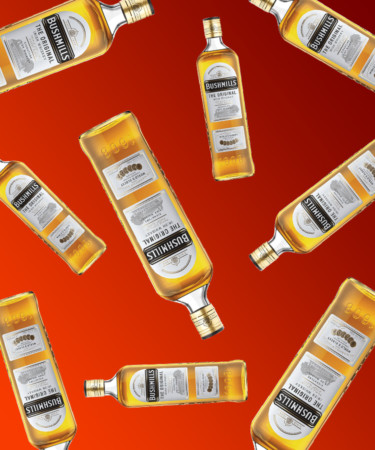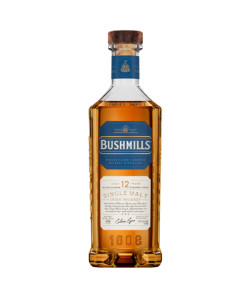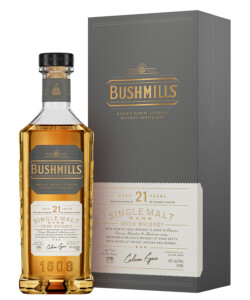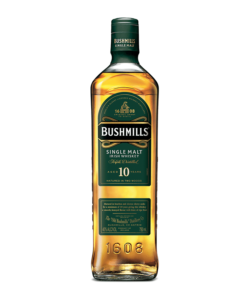There’s a long history behind Bushmills Irish whiskey. It’s one of the oldest players in the game, known for its single malt whiskeys and distinctly Irish roots. The brand calls the Emerald Isle home, but today, the distillery’s products are widely distributed across the globe.
Bushmills isn’t one to just rely on its storied past, though. The brand has worked to innovate over the years, adding 10-, 12-, and 17-year aged whiskeys to its portfolio in 1983 and releasing a bourbon cask aged whiskey in 2017. Its distillery continues to attract crowds, too. Bushmills remains the most visited distillery in Northern Ireland, and, in recent years, visitors from all corners of the world have made their way to the site to check out the Irish whiskey scene.
Here are 12 more things you should know about the historic Bushmills brand.
It might just be the oldest licensed whiskey distillery in the world.
Bushmills has been in the whiskey-making game for over 400 years. The brand is proud of its 1608 founding date, which is a focal point on every Bushmills bottle. To put its age into perspective, 1608 was 41 years after Henry VII and his six wives ruled England and 12 years before the Mayflower made its voyage to America. It was so long ago, in fact, that Bushmills is widely regarded as the oldest licensed whiskey distillery in the world. That year, Sir Thomas Phillips received the royal license to distill from King James I. Sir Thomas may have been the first to make whiskey on Bushmills distillery land, but he isn’t considered its founder. It took until 1784 for the distillery to become an official company, registered under the leadership of Hugh Anderson.
The name is a nod to Northern Ireland’s unique geography.
The Bushmills Distillery is nestled along the River Bush, a river that flows through cool, overcast Northern Ireland and into the nearby Atlantic Ocean. Water from the River Bush has been used for centuries to cut Bushmills’ whiskey down to 80 proof. Combine the barley mills used by the distillery and the River Bush, and the Bushmills name emerges. Bushmills, a name that reflects the geography of the region, is also the name of the larger village in which the distillery is located.
When the Crown imposed a barley tax, Bushmills paid the price to stay true to its recipe.
Malted barley was the bread and butter of Irish whiskey-making in the 18th century. That all changed drastically when the British government imposed the 1785 Malt Tax, an attempt to earn some additional coin from distillers and discourage excessive alcohol consumption.
In an effort to avoid having to fork over large sums of tax money, many distillers pivoted, including more unmalted barley in their mash bills to lower the cost. Others opted to use corn and avoid the tax entirely. Bushmills wasn’t interested in changing its ways, though. The brand footed the higher bill in hopes that it would pay off in the long run. Today, the distillery claims it’s the only one in Ireland that uses malted barley in all of its whiskeys.
It’s stuck to single malt through it all.
Bushmills opts for all barley, all the time. The distillery only makes single malt whiskeys, whiskeys that are entirely composed of barley and are the product of a single distillery. There are no blended whiskeys — meaning those made from barley and other grains — that bear the brand name. Bushmills was sure it wanted to stick with single malt even after the Malt Tax was enacted, and it hasn’t strayed since.
A distillery-destroying fire could have also destroyed the Bushmills name — but it didn’t.
Tragedy struck Bushmills in 1885 when a fire burned down the original distillery buildings. Rumor has it the bottles of whiskey were spared, though. The distillery was quickly rebuilt on a larger scale, and work resumed in the late 1880s.
Bushmills whiskey sailed across the ocean blue for the first time in 1890.
Bottles of whiskey were loaded onto a distillery-owned steamship — aptly named the SS Bushmills — and departed the Northern Ireland coast for the first time in 1890. The bounty sailed across the Atlantic in search of global success, making its mark first in the U.S., then expanding across the world.
In 2015, Bushmills introduced its Steamship Collection to commemorate the brand’s first ocean voyage. The line was released in celebration of the voyage’s 125th anniversary and features four special-edition Irish whiskies, each aged in a different spirits cask — bourbon, sherry, port, and rum.
Exports to the U.S. soared. Then, Prohibition hit.
American demand for Irish whiskey initially helped Bushmills become a successful name on the international market. Despite Ireland not having its own Prohibition, the 1920s plummet in demand due to American Prohibition left a gaping hole in Irish whiskey exports. Many distilleries in Ireland shuttered, and small distilleries funneled their efforts into the larger Bushmills and Middleton distilleries in hopes that they would survive. Fortunately they did, and Bushmills claims it sent its largest shipment to the U.S. in 1933, shortly after Prohibition’s repeal.
World War II delivered another (literal) hit to Bushmills’ Belfast headquarters.
Bushmills’ output slowed during World War II. Adopting the “do your part” wartime mentality, the distillery converted its space into temporary housing for Allied troops stationed in Ireland. No good deed goes unpunished, though. Bushmills’ Belfast headquarters, home to the company archives, was destroyed in a German bombing. When the war came to an end, Bushmills rebuilt and carried on.
Today, the whiskey brand is widely distributed across the world.
Despite a few historical setbacks that got in the way of the brand’s international distribution plans, the Bushmills name is known across the world. Today, it’s available at most liquor stores across the country. It’s also the third most popular Irish whiskey brand by sales (behind Jameson and Tullamore D.E.W) and has grown to reach non-European Union countries at a higher rate than ever before, with 25.6 million pounds of non-E.U. sales in 2018.
The Bank of Ireland features the distillery on its banknotes.
As an ode to Bushmills’ years of success for Northern Ireland’s economy, the Bank of Ireland introduced Northern Ireland banknotes that featured the distillery as a prominent feature on 5, 10, and 20 pound notes. The new design was first released in 2008, a date chosen to honor the 400th anniversary of Bushmills becoming a licensed distillery. The banknotes are still in use in Northern Ireland today.
You might have heard it referenced in pop culture.
Great booze brands seem to always make their way into songs, movies, and more. Bushmills is no exception, having had several moments in the spotlight. Some famous references include its mention in Irish writer James Joyce’s 1920 “Ulysses” novel and the 1976 Tom Waits song “Tom Traubert’s Blues.” It also shows up on the big screen in Quentin Tarantino’s 1997 film “Jackie Brown” and the 1997 Best Visual Effects Oscar winner “Independence Day.”
Bushmills is now part of the Casa Cuervo portfolio.
After an almost 10-year run with Diageo, Bushmills was sold to its current owner, Casa Cuervo, in 2014. The sale was part of what was essentially a trade between the two companies, as Diageo sold the brand in order to gain full control of Don Julio tequila. Bushmills is now in the lineup with Jose Cuervo tequilas along with 11 other whiskeys, tequilas, vodkas, and rum.



